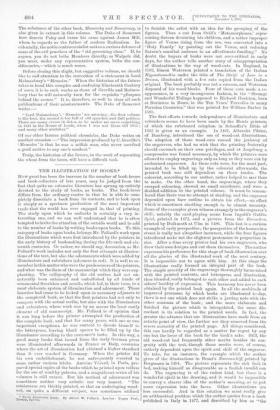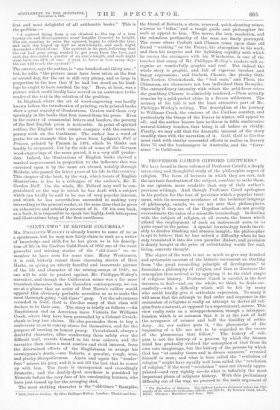THE ILLUSTRATION OF BOOKS.* How great has been the increase
in the number of book-lovers and book-collectors of late years, may be judged from the fact that quite an extensive literature has sprung up entirely devoted to the study of books, as books. The book-lover differs from the ordinary reader in that he is able to com- pletely dissociate a book from its contents, and to look upon it simply as a specimen production of the most important trade that the world has ever engaged in, that of printing. The study upon which he embarks is certainly a very in- teresting one, and we can well understand that he is often tempted to invite the attention of the outside world and to add to the number of books by writing books upon books, To this category of books upon books, belongs Mr. Pollard's work upon the illustrations which were first introduced by the printers in the early history of bookmaking during the fifteenth and six- teenth centuries. Or rather, we should say, decoration, as Mr. Pollard's work includes not only the first attempts at illustra- tions of the text, but also the adornments which were added by illuminators and rubrishers (adorners in red). It is well to re- member in thie matter who were the predecessors of the printers, and what was the form of the manuscript which they were sup- planting. The calligraphy of the old scribes had not un- naturally been enhanced and embellished by all kinds of ornamental flourishes and scrolls, which led, in their turn, to a most elaborate system of illumination and adornment. These beauties bad come to be looked upon "as necessary adjuncts to the completed book, so that the first printers had not only to compete with the actual scribe, but also with the illuminators and rubrishers, whose work was by no means the least costly element of old manuscript. Mr. Pollard is of opinion that it was long before the printer attempted the production of the complete book, and that for many years, with one or two important exceptions, he was content to devote himself to the letterpress, leaving blank spaces to be filled up by the illuminator according to the customer's taste. In this way, a good many books that issued from the early German press were illuminated afterwards in France or Italy, countries where the art of illumination had attained a higher standard than it ever reached in Germany. When the printer did his own embellishment, he not unfrequently resorted to some rather curious tricks. Antoine Verard, in Paris, pre- pared special copies of the books which he printed upon vellum for the use of wealthy patrons, and a magnificent series of his volumes is still extant. But his method of adornment was sometimes neither very artistic nor very honest. " The miniatures are thickly painted, so that an underlaying wood- cut, on quite a different subject, was sometimes utilised Ii xraU niustratfici Boeics, IIy Alfroa W, 1'o14rd. 1,collon icorquu Pula, Trough, and C:), to furnish the artist with an idea for the grouping of the figures. Thus a out from Ovid's Metamorphoses,' repre- senting Saturn devouring his children, and a rather improper figure of Venus rising from the sea, was converted into a Holy Family' by painting out the Venus, and reducing Saturn's cannibal embrace to an affectionate fondling." No doubt the buyers of books were not over-critical in early days, for the author tells another story of misappropriation of illustrations in the way of wood-cuts. In England, in 1592, Simon Waterson printed a translation of the Italian Hypnotomachia under the title of The ,Strife of love in a Dream, illustrated with a few cuts copied from the Italian original. The book probably was not a success, and Waterson disposed of his wood-blocks. Four of these cuts made a re- appearance, in a very incongruous fashion, in the " Strange and Wonderful Tidings happened to Richard Hasleton, born at Braintree in Essex, in the Ten Years' Travailes in many Forraine Countries," that was printed for William Barber in 1595.
The first efforts towards independence of illuminators and rubrishers seems to have been made by the Mentz printers, of which the rubricated colophon in Schoeffer's Bible of 1462 is given as an example. In 1461, Albrecht Pfister, of Bamberg, introduced the use of wood-cut illustrations. The adoption of these wood-cuts roused the jealousy of the engravers, who had no wish that the printing fraternity should encroach on their own privileges, and at Augsburg a compromise was found necessary, by which the printers were allowed to employ engravings only as long as they were cut by authorised engravers. As these cuts were, for the most part, intended to be filled up by the colourist afterwards, the printed book was still dependent on three trades. The colourist, according to our author, rather helped to mar than to make. On the other hand, the engravings, where they escaped colouring, showed no small excellence, and were a decided addition to the printed volume. It must be remem- bered that there was no attempt at shading, and the engraver depended upon bare outline to obtain his effect,—an effect which is sometimes startling enough to be almost uncanny. Some of the examples given witness strangely to the engraver's skill ; notably the card-playing scene from Ingold's Guldin Spiel, printed in 1472, and a picture from the Ennuchus, printed by Duikmuth at Ulm in 1486. This last is a curious example of early perspective ; the perspective of the houses in a street is really not altogether incorrect, while the four figures introduced make not the slightest pretension to proportion in size. After a time every printer had his own engravers, who drew their own designs and out them themselves. The author expresses his preference for this stage of book-illustration over all the glories of the illustrated work of the next century. It is impossible not to agree with him. At this stage the illustrations really formed an integral part of the book. The simple severity of the engravings thoroughly harmonised with the printed contents, and letterpress and illustration, thus blended, really belonged to each other and added to each others' lucidity of expression. This harmony has never been obtained by the printed book again. In all the multitude of improved processes by which books are illustrated to-day, there is not one which does not strike a jarring note with the other contents of the book; and the more elaborate and finished the picture which is interpolated, the more dis- cordant is its relation to the printed words. In fact, the greater the advance that our illustrations have made from an artistic point of view, the further are they removed from the severe austerity of the printed page. All things considered, this can hardly be regarded as a matter for regret by any one but the lover of the book for the book's sake. Still, the old wood-cut had frequently other merits besides its con- gruity with the text, though those merits were, of course, entirely dependent upon the spirit and skill of the engraver. To take, for an instance, the example which the author gives of the illustrations in Brant's Narrensehj, printed by Bergmann in 1494, The picture represents the sick fool, in bed, making himself as disagreeable as a foolish invalid can do. The engraving is of the rudest kind, but there is a wonderful spirit in the drawing, and it would be impossible to convey a clearer idea of the author's meaning, or to put more expression into the faces. Other illustrations are less successful. And in this relation we must really give an arithmetical problem which the author quotes from a book published in Italy in 1477, and desoribod by him as "the first and most delightful of all arithmetic books." This is the problem :- '° A. squirrel flying from a cat climbed to the top of a tree twenty-six and three-quarters arms'-lengths (braccie) in height. Tho cat, wanting to seize the squirrel, began to climb the tree, and each day leaped up half an arm's-length, and each night descended a third of one. The squirrel, in its part, believing that the cat had gone away, wanted to get away from the tree, and each day descended a quarter of an arm's-length, and each night went back one-fifth of one. I want to know in how 'limy days the cat will reach the squirrel'?"
The answer, says the author, is "one hundred and thirty-one ;" but, he adds, " the picture must have been taken on the first or second day, for the cat is still very plump, and so large in proportion to the tree that if he had but stood on his hind- legs he ought to have reached the top." Here, at least, was a picture which could hardly have served as an assistance to the reader of the text in the solution of the problem.
In England, where the art of wood-engraving was hardly known before the introduction of printing, early printed books show a great scarcity of illustrations. Caxton used them very sparingly in the books that first issued from his press. Even in the matter of ornamental letters and borders, the poverty of the first English press is noticeable. In point of spirited outline, the English work cannot compare with the contem- porary work on the Continent. The author has a word of praise for an example that he gives from Lydgate's Fall of Princes, printed by Pynson in 1494, which he thinks can hardly be surpassed ; but by the side of some of the German wood-engravings of the same period, it is a very stiff produc- tion. Indeed, the illustrations of English books showed a marked improvement in proportion to the influence that was exercised upon it by the same art abroad, notably through Holbein, who passed the latter years of his life in this country. This chapter of the book, by the way, which treats of English illustrations, is due to a colleague of the author's, Mr. E. Gordon Duff. On the whole, Mr. Pollard may well be con- gratulated on the way in which he has dealt with a subject which can hardly be said to be one of very popular interest, and which he has nevertheless succeeded in making very interesting to the general reader, at the same time that he gives an exhaustive and scholarly account of it. Of his own book, as a book, it is impossible to speak too highly, both letterpress and illustrations being of the first excellence.





















































 Previous page
Previous page